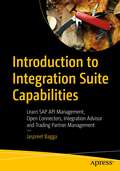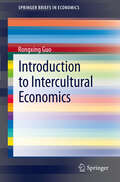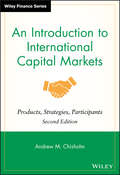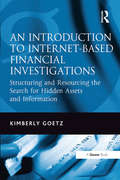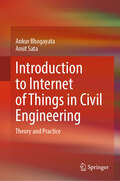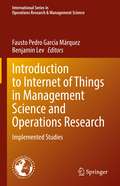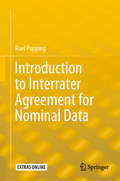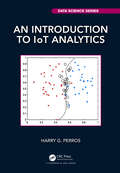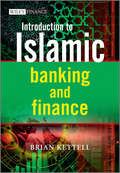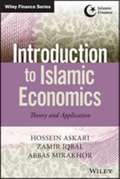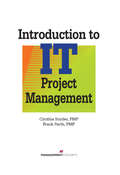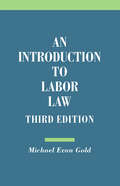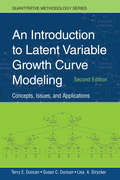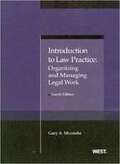- Table View
- List View
Introduction to Integration Suite Capabilities: Learn SAP API Management, Open Connectors, Integration Advisor and Trading Partner Management
by Jaspreet BaggaDiscover the power of SAP Integration Suite's capabilities with this hands-on guide. Learn how this integration platform (iPaaS) can help you connect and automate your business processes with integrations, connectors, APIs, and best practices for a faster ROI. Over the course of this book, you will explore the powerful capabilities of SAP Integration Suite, including API Management, Open Connectors, Integration Advisor, Trading Partner Management, Migration Assessment, and Integration Assessment. With detailed explanations and real-world examples, this book is the perfect resource for anyone looking to unlock the full potential of SAP Integration Suite. With each chapter, you'll gain a greater understanding of why SAP Integration Suite can be the proverbial swiss army knife in your toolkit to design and develop enterprise integration scenarios, offering simplified integration, security, and governance for your applications. Author Jaspreet Bagga demonstrates how to create, publish, and monitor APIs with SAP API Management, and how to use its features to enhance your API lifecycle. He also provides a detailed walkthrough of how other capabilities of SAP Integration Suite can streamline your connectivity, design, development, and architecture methodology with a tool-based approach completely managed by SAP. Whether you are a developer, an architect, or a business user, this book will help you unlock the potential of SAP's Integration Suite platform, API Management, and accelerate your digital transformation. What You Will Learn Understand what APIs are, what they are used for, and why they are crucial for building effective and reliable applicationsGain an understanding of SAP Integration Suite's features and benefits Study SAP Integration assessment process, patterns, and much moreExplore tools and capabilities other than the Cloud Integration that address the full value chain of the enterprise integration components Who This Book Is For Web developers and application leads who want to learn SAP API Management.
Introduction to Intercultural Economics
by Rongxing GuoThis book presents a methodological framework for the analysis of intercultural issues frequently misinterpreted by existing theories. It uses a challenge-and-response theory of cultural development to examine the relationship between different natural disasters and threats and the developments of ancient civilizations. The spatial interaction of ancient civilizations is assessed; and four non-linear patterns of intercultural dynamics are presented. Our empirical analyses of the four major ancient civilizations (the Mesopotamian, the Egyptian, the Indus, and the Chinese) focus on intercultural influences as well as how they have shaped the spatial dynamics of the world as a whole. This book also examines various aspects of intercultural economic influences, such as those of culture on international trade. Evidence from a broad panel of nations supports the presumption that high-income trade partners will be less sensitive to the measures of cultural dissimilarity than low-income trade partners between which cultural dissimilarity leads to barriers to international trade. The treatment of linguistic and religious factors as continuous variables in this book has improved past studies in which 'language' was treated as one or more dummy variables and 'religion' was ignored.
An Introduction to International Capital Markets
by Andrew M. ChisholmFully revised and updated from the hugely popular first edition, this book is an accessible and convenient one-volume introduction to international capital markets, ideal for those entering or planning to enter investment banking or asset management. As well as serving as an invaluable reference tool for professionals already working in the industry looking to extend their knowledge base it will also benefit all those working in trading, sales and support roles.Describing how the key products and markets work, who the principle participants are and their overall goals and objectives, Andrew Chisholm provides a thorough overview of the global capital markets. The book covers a wide range of equity, debt, foreign exchange and credit instruments as well as the principal derivative products. In a step-by-step fashion, making extensive use of real world cases and examples, it explains money markets, foreign exchange, bond markets, cash equity markets, equity valuation techniques, swaps, forwards, futures, credit derivatives, options, option risk management and convertible bonds. An extensive glossary also explains concisely many of the 'jargon' expressions used in the financial markets.Boasting an international focus, examples are drawn from major international markets around the world. It makes extensive use of numerical examples and case studies to help explain a wide range of cash and derivative products used in the capital markets business. It covers both debt and equity products and includes new material on credit products such as collateralized debt obligations and credit derivative structures; equity fundamental analysis, portfolio theory and convertible bonds. Market data has been fully updated from the first edition and recent events such as the 'credit crisis' are discussed.
An Introduction to International Economics
by Kenneth A. ReinertThis book is designed for a one-semester or two-semester course in international economics, primarily targeting non-economics majors and programs in business, international relations, public policy and development studies. It has been written to make international economics accessible to wide student and professional audiences. The book assumes a minimal background in microeconomics and mathematics and goes beyond the usual trade-finance dichotomy to give equal treatment to four 'windows' on the world economy: international trade, international production, international finance and international development. It takes a practitioner point of view rather than a standard academic view, introducing the student to the material they need to become effective analysts in international economic policy. The website for the text is found at http://iie.gmu.edu.
Introduction to International Economics (Third Edition)
by Dominick SalvatoreThe aim of this text is to provide the student with an introduction to the field of international economics using many real-world case studies.
An Introduction to International Investment Law
by David CollinsThis insightful and accessible introduction provides students and practitioners with a comprehensive overview of the increasingly important discipline of international investment law. Focusing primarily on the legal principles contained in the growing body of international investment agreements, this book covers the core concepts of the discipline with attention given to their relation to each other and to the manner in which they have been developed through arbitration case law. The context of each legal principle is explored along with a consideration of some of the major debates and emerging criticisms. Avoiding extensive case extracts, this book adopts an engaging and succinct narrative style which allows readers to advance their understanding of the topic while examining the legal principles with academic rigour and discerning commentary.
Introduction to International Political Economy
by David N. Balaam Bradford DillmanA complete and accessible overview of how politics and economics collide in a global context This text surveys the theories, institutions, and relationships that characterize IPE and highlights them in a diverse range of regional and transnational issues. The bestseller in the field, Introduction to International Political Economy positions students to critically evaluate the global economy and to appreciate the personal impact of political, economic, and social forces.
An Introduction to Internet-Based Financial Investigations: Structuring and Resourcing the Search for Hidden Assets and Information
by Kimberly GoetzIncreasingly, employees of regulatory bodies, law enforcement agencies and others who are not trained forensic accountants or experienced investigators find themselves responsible for conducting what amount to financial investigations. An engineer who oversees the cleanup of a toxic waste site might need to track down the former owners of the site to find the polluter. Perhaps the applicable licensing agency receives a complaint that an attorney mishandled a client's money. Maybe it's the attorney who needs help finding the assets with which a client's former spouse has absconded. Training in investigation techniques tends to be very limited for many employees. Training on how to find information without incurring significant expense is virtually nonexistent. This book helps fill the void. An Introduction to Internet-Based Financial Investigations will help anyone who conducts financial investigations as part of their job to reduce their dependence on trial and error by showing them where and how to look. Using clear sections describing how to approach an investigation, including the ethical perspective; what to look for and what you find; what free and low cost internet resources are available to support investigations; and how to assemble and present the results of investigations, Kimberly Goetz guides students and beginning investigators through the complex world of financial investigations.
Introduction to Internet of Things in Civil Engineering: Theory and Practice
by Ankur Bhogayata Amit SataThis textbook provides introductory concepts of the Internet of Things (IoT) in a concise and clear format. It presents in-depth information on the technological transformations and attributes of IoT. It also presents various examples of the applications of IoT in the field of civil engineering, both in laboratories and in the field. Various self-explanatory illustrations, figures, photographs and numerical details are included for a better understanding of concepts. A summary of contents and a list of review questions are provided at the end of each section for self-evaluation of the learnings from each chapter. A dedicated chapter for teachers is also provided which discusses pedagogy and curriculum development for the emerging field of IoT with reference to civil engineering education. The book also suggests methods of utilisation and integration of IoT concepts in education through assignments, tutorials, project works and research topics. This book is a valuable learning resource for undergraduate civil engineering students with limited exposure to computer science and engineering. It also functions as a reference resource for postgraduate students and scholars dealing with the application of IoT in civil engineering.
Introduction to Internet of Things in Management Science and Operations Research: Implemented Studies (International Series in Operations Research & Management Science #311)
by Fausto Pedro García Márquez Benjamin LevThis book aims to provide relevant theoretical frameworks and the latest empirical research findings in Internet of Things (IoT) in Management Science and Operations Research. It starts with basic concept and present cases, applications, theory, and potential future. The contributed chapters to the book cover wide array of topics as space permits. Examples are from smart industry; city; transportation; home and smart devices. They present future applications, trends, and potential future of this new discipline. Specifically, this book provides an interface between the main disciplines of engineering/technology and the organizational, administrative, and planning capabilities of managing IoT. This book deals with the implementation of latest IoT research findings in practice at the global economy level, at networks and organizations, at teams and work groups and, finally, IoT at the level of players in the networked environments. This book is intended for professionals in the field of engineering, information science, mathematics, economics, and researchers who wish to develop new skills in IoT, or who employ the IoT discipline as part of their work. It will improve their understanding of the strategic role of IoT at various levels of the information and knowledge organization. The book is complemented by a second volume of the same editors with practical cases.
Introduction to Interrater Agreement for Nominal Data (SpringerBriefs in Statistics)
by Roel PoppingThis introductory book enables researchers and students of all backgrounds to compute interrater agreements for nominal data. It presents an overview of available indices, requirements, and steps to be taken in a research project with regard to reliability, preceded by agreement. The book explains the importance of computing the interrater agreement and how to calculate the corresponding indices. Furthermore, it discusses current views on chance expected agreement and problems related to different research situations, so as to help the reader consider what must be taken into account in order to achieve a proper use of the indices.The book offers a practical guide for researchers, Ph.D. and master students, including those without any previous training in statistics (such as in sociology, psychology or medicine), as well as policymakers who have to make decisions based on research outcomes in which these types of indices are used.
An Introduction to IoT Analytics (Chapman & Hall/CRC Data Science Series)
by Harry G. PerrosThis book covers techniques that can be used to analyze data from IoT sensors and addresses questions regarding the performance of an IoT system. It strikes a balance between practice and theory so one can learn how to apply these tools in practice with a good understanding of their inner workings. This is an introductory book for readers who have no familiarity with these techniques. The techniques presented in An Introduction to IoT Analytics come from the areas of machine learning, statistics, and operations research. Machine learning techniques are described that can be used to analyze IoT data generated from sensors for clustering, classification, and regression. The statistical techniques described can be used to carry out regression and forecasting of IoT sensor data and dimensionality reduction of data sets. Operations research is concerned with the performance of an IoT system by constructing a model of the system under study and then carrying out a what-if analysis. The book also describes simulation techniques. Key Features IoT analytics is not just machine learning but also involves other tools, such as forecasting and simulation techniques. Many diagrams and examples are given throughout the book to fully explain the material presented. Each chapter concludes with a project designed to help readers better understand the techniques described. The material in this book has been class tested over several semesters. Practice exercises are included with solutions provided online at www.routledge.com/9780367686314 Harry G. Perros is a Professor of Computer Science at North Carolina State University, an Alumni Distinguished Graduate Professor, and an IEEE Fellow. He has published extensively in the area of performance modeling of computer and communication systems.
Introduction to Islamic Banking and Finance
by Brian KettellIntroduction to Islamic Banking and Finance is a succinct guide to the key characteristics of Islamic banking highlighting how these differ from conventional banking. This detailed book illustrates how Islamic banking is consistent with the Sharia'a, a key element of which is the prohibition on collecting and paying interest. This central religious precept appears to rule out most aspects of modern finance but it does allow money to be used for trading tangible assets and business, which can then generate a profit. Brian Kettell's book looks at all aspects of Islamic banking, including chapters on its creation and evolution through to detailed discussions of the issues involved in the Sharia'a contracts of Murabaha, Mudaraba, Musharaka, Ijara, Istisna'a, and Salam. Islamic insurance (Takaful) is also covered. Finally the book takes a look at Sharia'a law and Sharia'a boards, indicating the roles and responsibilities that come with membership.Islamic banks have been operating in places such as Bahrain, Saudi Arabia, Malaysia and Dubai for some time. Conventional bankers have traditionally viewed the sector as a small, exotic niche but recent years have seen a dramatic surge in popularity. A number of Western investment banks have started working with Muslim clerics to create new ranges of financial products designed for devout Muslims, a large and growing market. Although estimates of the size of the Islamic finance industry vary greatly, everyone agrees that it is expanding rapidly and this is the perfect book for anyone looking to understand the industry.
Introduction to Islamic Economics
by Abbas Mirakhor Zamir Iqbal Hossein AskariGain deeper insight into the principles and theory of Islamic economicsIntroduction to Islamic Economics: Theory and Application provides an overview of the organizing principles and fundamentals of an Islamic economy. With deep discussion of the characteristics, rationale, key institutions, objectives, and instruments at work, the book addresses the core economic principles underlying a system based on the foundational teachings of Islam, and examines the implications for economic policies. Social welfare, economic justice, market functionality, efficiency, and equity are explored from an Islamic perspective, and the role and instruments of fiscal and monetary policy in Islamic systems are used to illustrate contemporary applications.Universities around the globe are offering courses on Islamic economics and finance, but despite the industry's rapid growth, most research has been focused on the financial principles rather than underlying economic principles. The first book of its kind, Introduction to Islamic Economics brings all the key concepts together into one reference volume. By outlining the ways in which Islamic finance and Islamic economics interrelate, this book can help readers to:Develop an understanding of the Islamic economic system and its institutional scaffoldingDifferentiate between the major characteristics of the dominant conventional economy and one based on the fundamental sources of IslamUnderstand the conditions that must be met for a just, well-balanced, stable, and growing economyClarify the role of State, public policy, and risk-sharing in the Islamic financial systemThe Islamic financial system is expanding quickly, and those looking to increase their relevance in a changing economic landscape must get up to speed. Introduction to Islamic Economics provides a comprehensive overview of underlying economic system offering a deeper understanding of the feature of the system. This book is an excellent complement to Introduction to Islamic Finance, 2E by Iqbal and Mirakhor.
Introduction to Islamic Finance
by Benjamin C. Esty Fuaad A. Qureshi Mathew Mateo MillettProvides a basic introduction to the principles of Islamic finance. Examines the religious background and legal foundations of Islamic finance. Also discusses the development of Islamic financial institutions and the financial instruments they use. Concludes with a discussion of recent developments and future challenges for this growing segment of the global financial system.
Introduction to IT Project Management
by Cynthia Snyder Pmp Frank Parth PmpIntroduction to IT Project Management provides IT project managers the practical tools needed to maintain daily operations while managing multiple projects. This valuable reference helps IT project managers, CIOs, and project sponsors understand the IT project environment so that projects can be managed much more efficiently and successfully. An instructor's guide is available.
Introduction to Knowledge Management: Km In Business
by Todd Groff Thomas JonesThis book introduces readers to a wide range of knowledge management (KM) tools, techniques and terminology for enhancing innovation, communication and dedication among individuals and workgroups. The focus is on real-world business examples using commonly available technologies. The book is set out in a clear and straightforward way, with definitions highlighted, brief case studies included that illustrate key points, dialogue sections that probe for practical applications, and written exercises. Each chapter concludes with discussion questions, review questions, and a vocabulary review. An Online Instructor's Guide is available.
An Introduction To Labor Law
by Michael Evan GoldAn Introduction to Labor Law is a useful and course-tested primer that explains the basic principles of the federal law regulating the relationship of employers to labor unions. In this updated third edition, which features a new introduction, Michael Evan Gold discusses the law that applies to union organizing and representation elections, the duty to bargain in good faith, economic weapons such as strikes and lockouts, and the enforcement of collective bargaining agreements. Gold describes the structure and functions of the National Labor Relations Board and of the federal courts in regard to labor cases and also presents a number of legal issues presently in contention between labor and management.
An Introduction to Latent Variable Growth Curve Modeling: Concepts, Issues, and Application, Second Edition (Quantitative Methodology Series)
by Terry E. Duncan Susan C. Duncan Lisa A. StryckerThis book provides a comprehensive introduction to latent variable growth curve modeling (LGM) for analyzing repeated measures. It presents the statistical basis for LGM and its various methodological extensions, including a number of practical examples of its use. It is designed to take advantage of the reader’s familiarity with analysis of variance and structural equation modeling (SEM) in introducing LGM techniques. Sample data, syntax, input and output, are provided for EQS, Amos, LISREL, and Mplus on the book’s CD. Throughout the book, the authors present a variety of LGM techniques that are useful for many different research designs, and numerous figures provide helpful diagrams of the examples. Updated throughout, the second edition features three new chapters—growth modeling with ordered categorical variables, growth mixture modeling, and pooled interrupted time series LGM approaches. Following a new organization, the book now covers the development of the LGM, followed by chapters on multiple-group issues (analyzing growth in multiple populations, accelerated designs, and multi-level longitudinal approaches), and then special topics such as missing data models, LGM power and Monte Carlo estimation, and latent growth interaction models. The model specifications previously included in the appendices are now available on the CD so the reader can more easily adapt the models to their own research. This practical guide is ideal for a wide range of social and behavioral researchers interested in the measurement of change over time, including social, developmental, organizational, educational, consumer, personality and clinical psychologists, sociologists, and quantitative methodologists, as well as for a text on latent variable growth curve modeling or as a supplement for a course on multivariate statistics. A prerequisite of graduate level statistics is recommended.
An Introduction to Latin American Economics: Understanding Theory Through History
by Scott McKinneyThis textbook serves as an introduction to the major economic topics and events in Latin America’s history, from the settling of the region by indigenous Americans and then Europeans, Africans and Asians, to the economic consequences of COVID-19. Each chapter concentrates on a particular period—for example, pre-Columbian America, the 1980s debt crisis, the 21st Century decline in income inequality—and introduces the concepts needed to understand the events of that period. These concepts include theories such as Dutch Disease and Dependency Theory, policies such as import-substituting industrialization and neoliberalism, and analytical tools such as the circular flow of income and the foreign exchange market. Descriptive data are used to illustrate these concepts: for example, Latin America’s current account balance during the 1970s and 1980s shows the impact of the debt crisis, while the relationship between money supply growth and inflation in Argentina during the 1980s and 1990s shows the impact of expansionary monetary policy and convertibility.With its focus on Latin American economic history and on the key concepts for understanding that history, this book can serve as the core textbook for an introductory course on Latin American Economics, or as a complementary text for an introductory course in Latin American Studies or a social science course on Latin America.
An Introduction to Law and Regulation: Text and Materials (Law in Context)
by Karen Yeung Sofia RanchordásContemporary life relies on regulation. The quality and safety of the water we drink, the food we eat, and the social media applications we use are all governed by multiple regulatory regimes. Although rooted in law, regulation is a multidisciplinary endeavour. Debates about regulation, particularly in the face of rapid change and the emergence of new 'risks', are now commonplace. Despite extensive scholarship, regulation is often poorly understood, even by policy-makers, with unintended and even disastrous consequences. This book offers a critical introduction to core theories, concepts, methods, tools, and techniques of regulation, including regulatory policy, instruments, enforcement, compliance, accountability and legitimacy. Weaving extracts from texts drawn from many disciplines with accessible commentary, it introduces this important field to students, scholars, and practitioners in a scholarly yet accessible and engaging manner with discussion questions and additional readings for those seeking to deepen their knowledge.
Introduction to Law Enforcement and Criminal Justice
by Christine Hess Orthmann Henry Lim Cho Kären Matison HessThis comprehensive and practical book covers law enforcement and the criminal justice system as a whole (including courts, corrections, and juvenile justice) in one easy-to-understand volume. You'll find a realistic and relevant "boots on the street" perspective, real world examples in every chapter, and up-to-date information on a wide range of today's hottest topics. You'll learn about the ways technology is changing the day-to-day operations of policing and police interaction with the public; the recommendations of the President's Task Force on 21st Century Policing, including the need to improve trust and legitimacy with the public and a shift away from the warrior mentality to a guardian mindset; the law enforcement response to new terrorism threats such as ISIS and homegrown violent extremists; drones and other new surveillance techniques; and more.
Introduction to Law Firm Practice
by Michael DowneyWriting for law school students expecting to enter a private law firm after graduation, Downey (Washington U. School of Law in St. Louis) describes how law firms operate and are managed. Chapters address such topics as office-sharing arrangements, referral arrangements outside law firms, the form of law firms, law firm governance, types of lawyers in law firms, administrative organizational structures, interactions with non-lawyer staff, partnerships, the market for legal services, types of law practices, how fees are assessed, other sources of firm revenue, law firm profitability, client and matter profitability, compensation, intake of a client matter, time billing, managing client work, pro bono work, business development, client relationship management, lending clients money, firm culture and demands on time, lawyer's professional liability insurance, potential malpractice claims, disciplinary complaints, diversity in law firms, mentoring, and supervision and risk management. Annotation ©2011 Book News, Inc. , Portland, OR (booknews. com)
Introduction to Law Practice: Organizing and Managing Legal Work
by Gary A. MunnekeThis casebook introduces practice management skills in a variety of areas, including formation of a firm, development of a marketing plan, hiring and retaining staff, setting up a law office, leveraging the lawyer's intellectual work product, marshalling IT resources, establishing office systems, setting and collecting fees, and managing a budget. The new edition features an entirely new first section called "The Business of Law" which focuses on the economics of the profession and looks at the changing business model of law firms and billing practices. This edition also has new sections focusing on creating "practice-ready" lawyers
